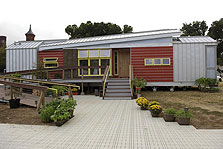
 Enlarge image
Enlarge image
Materials used in the construction and furnishings of CU's BioS(h)IP include agricultural products and byproducts such as soy, corn, coconut, wheat, canola oil, citrus oils, sugar, and even chocolate.
(Credit: Chris Gunn/U.S. Department of Energy Solar Decathlon)
Who: University of Colorado
What: BioS(h)IP
Where:
Private Residence
Provo, UT
Map This House
Public tours: Not available
Solar Decathlon 2005
University of Colorado: Pioneering New Technologies
The University of Colorado team won the U.S. Department of Energy Solar Decathlon 2005 with its innovative house, BioS(h)IP. Five years later, in August 2010, the university sold the house at auction for $27,222.98 to a private buyer from Provo, Utah.
BioS(h)IP went into storage on campus after returning from the National Mall. The team had originally planned to sell the house to a new urbanist development in Longmont, Colorado, following the competition. However, a decline in the housing market caused the developer to abandon its partnership with the university.
While the house was in storage for almost five years, its building envelope technology went on to receive an architectural patent and form the basis of a start-up company. BioS(h)IP derived its name from the bio-based structural insulated panel system (BioSIPs) used in the house. Made from agricultural and post-consumer waste, this technology embodies the "low-to-no petroleum" mindset that guided the University of Colorado team throughout the competition.
Architecture faculty lead Julee Herdt pioneered BioSIPs in her own home before bringing a first-generation version to life in the 2005 house. "The Solar Decathlon helped push an idea forward that probably would never have happened otherwise," says Herdt. "The legacy of this house grows as we bring its bio-based building technology to market."
